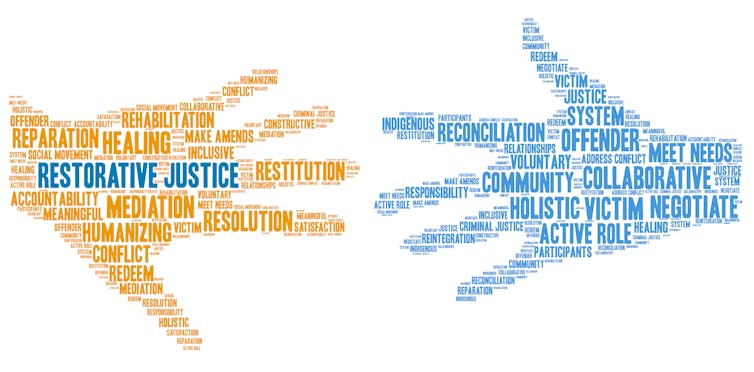
Restorative justice was introduced in the western world in the late 1970s as a way to rethink crime and punishment. It’s an approach to criminal justice that sees crime as a violation of people and relationships and makes it the obligation of those responsible to put right the wrongs committed.
In time, restorative justice grew to include nurturing relationships and is now also practiced in education, community, employment and environmental contexts.
Indigenous communities around the world have always lived in alignment with what we now call restorative justice — it is tied to Indigenous worldviews and influences all aspects of life. When understood holistically, restorative justice has the incredible potential to support healthy community life.
And while advocates of restorative justice may acknowledge its Indigenous roots, meaningful collaborative dialogue and leadership with Indigenous people is often lacking.
Why are Indigenous Peoples’ worldviews not more involved in growing restorative justice’s approach? Could it be that they once offered insights, but a willingness to listen was missing?
Two-eared listening
At a National Restorative Justice Week panel in 2018, Chief Mi’sel Joe (one of the authors of this piece) from Miawpukek First Nation said, “If you want to know about restorative justice, just ask.”
Chief Joe’s invitation challenged panel attendees by forcing them to acknowledge how white-centric the field was. It encouraged people to question how a western perspective of restorative justice might be contributing to colonization.
True to his word, Chief Joe was willing to answer the question. So we embarked on planning an event, Two-Eared Listening for Deeper Understanding: Restorative Justice in N.L., where Indigenous people would lead attendees towards a deeper collective understanding of restorative justice.
Read more: Respect for Indigenous knowledge must lead nature conservation efforts in Canada
From the start, our academic approach was challenged and we learned to listen deeply. After watching a video clip of Mi’kmaw Elder Albert Marshall explaining the concept of two-eyed seeing, Chief Joe shares:
“What we are doing is not two-eyed seeing, but two-eared listening. At the heart of justice is listening. Before you can restore justice, you need to listen to the stories of injustice.”
We realized that what we were being taught, and what we had been learning, was encompassed in this term two-eared listening.
Two-eared listening is based on the idea of learning and understanding, a willingness to suspend judgment and the desire to communicate respectfully in a way that might challenge previously held beliefs or assumptions. Chief Joe says:
“When we talk about justice and injustice, that concept is not just spoken words. Injustice is about hurt and pain, so that brings in parts of our body, including the heart and soul. [This talking] includes body language [and] knowing someone is listening and caring. If you are listening from your core, you will understand the telling of these stories of justice and injustice.”
Restorative justice in Newfoundland and Labrador
After over two years of planning and discussing restorative justice we held a three-day event in November 2021. Every component was led by Indigenous people and two-eared listening was the key focus.
The event was a technology-free space that allowed people to be present without distractions. Attendees practised two-eared listening by being open to receiving new learning, suspending judgment, listening with intention and purposefully engaging in (re)conciliation.
Each day began with Elders smudging, lighting the kudlik (a traditional lamp used by Inuit on the coast of Labrador) and offering prayers. The event featured insights and teachings from Elders and musicians, community leaders who presented contemporary realities and sessions that focused on education, community and justice.
Elders shared stories and reflections, and the event concluded with prayers and blessings followed by a meal and a mide-wiigwas, a Mi’kmaw ceremony of gift exchange.
As participants and presenters left the gathering, we heard repeatedly, “We need to do this again!” and planning has already begun for future events.

Two-eared listening paved the way for deep listening, which is a critical part of truth-telling in the restorative justice process. But it’s just the beginning; truth must be followed by action and take on new meaning, otherwise current conditions will remain unchanged.
As restorative justice continues to be developed and practised in western contexts, it is imperative that Indigenous people lead the conversations and non-Indigenous people listen with two ears. In this way, the load of (re)conciliation can be carried together “in a good way.”
Two-eared listening is a critical element for western advocates of restorative justice. Acknowledging the Indigenous roots of restorative justice is not enough. Authentic relationships that allow for reciprocal engagement and leadership that look at and listen to the past, present and future are required — not just for the healing of the Nations, but for the well-being of all.
Dorothy Vaandering works for Memorial University of Newfoundland and Labrador. She receives funding from Social Sciences and Humanities Research Council and the Department of Justice and Public Safety of NL. She is affiliated with Relationships First: Restorative Justice Consortium, NL.
Rosemary Ricciardelli receives funding from the Canadian Institute of Health Research and the Social Science and Humanities Research Council of Canada.
Sulaimon Giwa receives funding from the Social Sciences and Humanities Research Council (SSHRC). He is a member of the SSHRC Advisory Committee to Address Anti-Black Racism in Research and Research Training Programs.
Sylvia Moore receives funding from Social Sciences and Humanities Research Council of Canada (SSHRC).
Chief Mi’sel Joe does not work for, consult, own shares in or receive funding from any company or organization that would benefit from this article, and has disclosed no relevant affiliations beyond their academic appointment.
This article was originally published on The Conversation. Read the original article.







